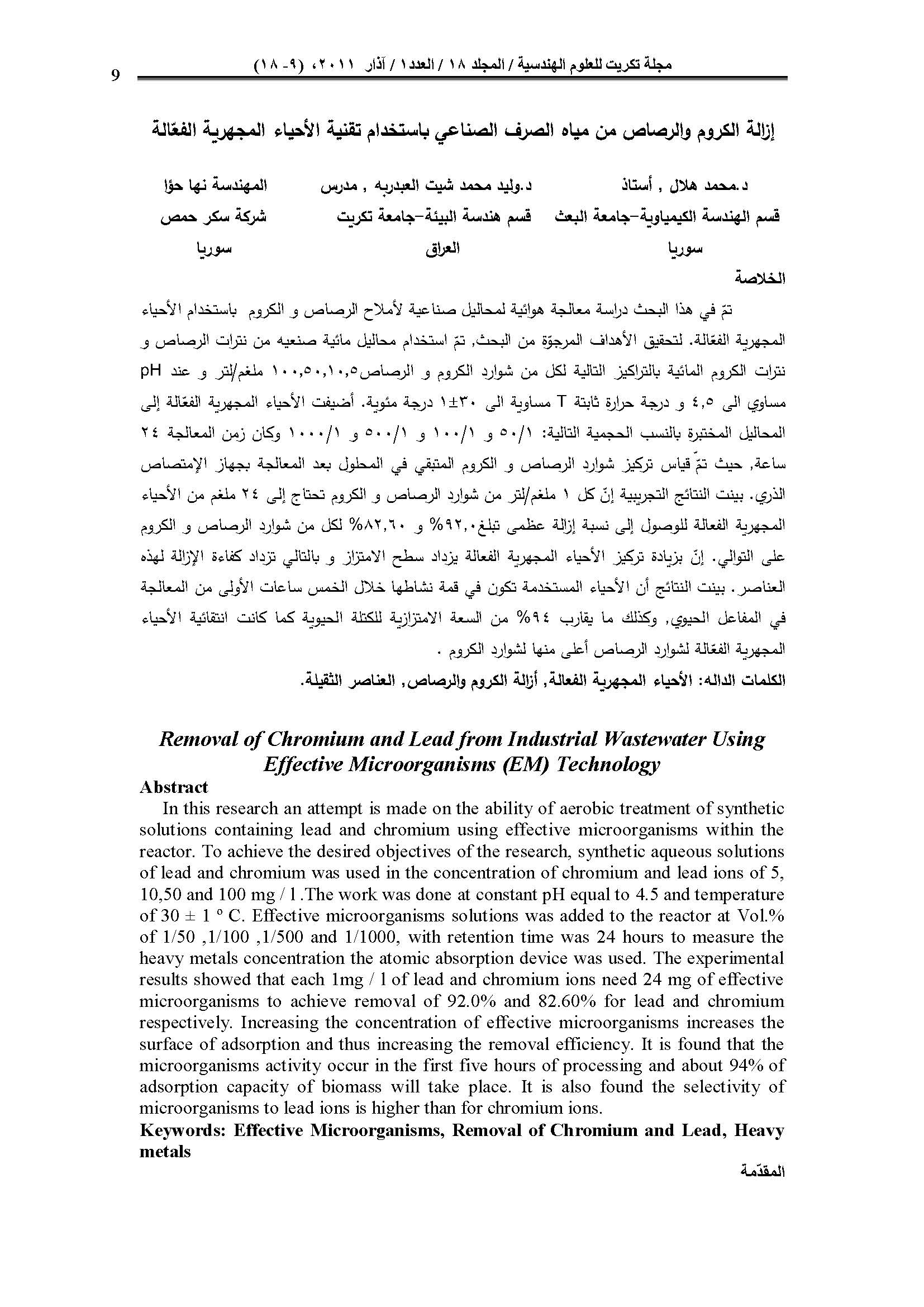Removal of Chromium and Lead from Industrial Wastewater Using Effective Microorganisms (EM) Technology
محتوى المقالة الرئيسي
الملخص
In this research an attempt is made on the ability of aerobic treatment of synthetic solutions containing lead and chromium using effective microorganisms within the reactor. To achieve the desired objectives of the research, synthetic aqueous solutions of lead and chromium was used in the concentration of chromium and lead ions of 5, 10,50 and 100 mg / l .The work was done at constant pH equal to 4.5 and temperature of 30 ± 1 º C. Effective microorganisms solutions was added to the reactor at Vol.% of 1/50 ,1/100 ,1/500 and 1/1000, with retention time was 24 hours to measure the heavy metals concentration the atomic absorption device was used. The experimental results showed that each 1mg / l of lead and chromium ions need 24 mg of effective microorganisms to achieve removal of 92.0% and 82.60% for lead and chromium respectively. Increasing the concentration of effective microorganisms increases the surface of adsorption and thus increasing the removal efficiency. It is found that the microorganisms activity occur in the first five hours of processing and about 94% of adsorption capacity of biomass will take place. It is also found the selectivity of microorganisms to lead ions is higher than for chromium ions.
المقاييس
تفاصيل المقالة

هذا العمل مرخص بموجب Creative Commons Attribution 4.0 International License.
THIS IS AN OPEN ACCESS ARTICLE UNDER THE CC BY LICENSE http://creativecommons.org/licenses/by/4.0/
##plugins.generic.plaudit.displayName##
المراجع
- EM Pakistan" EM Technology In Petroleum Industry", (No Date) URL:http//:www.embiotech.org
- Hega; T. and Parr; J. F.,"Beneficial Effective Microorganisms for a Sustainable Agriculture and Environment", International Nature Farming Research Center, Atami, Japan 1994.
- Shintani, M.,"A Microorganisms Used for the Production of EM-1" EMRO USA Effective Microorganisms, 2005.
-Ibo, Z. and James H," Example of an Integrated Biosystem, Incorporating Effective Microorganisms", Water Management Conference, Worcester Polytechnic Institute, 16 June 2004
- Nathan; S. And Robert; A. P,
“Effective Microorganism (EM) and Wastewater Systems", University of New England, 2003.
- Kim S. U, Y.H. Cheong, D.C. Seo, J.S. Hur, J.S. Hero and J.S. Cho "Characterization of Heavy Metal to Lerance and Biosorption Capacity of Bacterium Strain CPB4", (Bacillus spp.)" doi: 10.2166/wst.2007.
-Khanafari A., S. Eshghdoost, A. Mashinchian " Removal of Lead and
Chromium from Aqueous Solution by Bacillus Circulans Biofilm", Iran. J. Environ. Health . Sci. Eng., 2008, Vol. 5, No. 3, pp. 195-200
-Rivera-Utrilla, I. Bautista-Toledo, M.A. Ferro-Garc´ıa, C. Moreno-Castilla, "Bioadsorption of Pb(II), Cd(II), and Cr(VI) on Activated carbon from Aqueous Solutions", Carbon 41 (2003) 323–330-2002. DOI: https://doi.org/10.1016/S0008-6223(02)00293-2
-EM RESEARCH ORGANIZATION for Middle East & Central Asia, “Tannery Sludge Bioremediation and its Reuse in Agriculture Using EM
Technology" ,EASTERN LEATHER COMPANY; Sheikhupura road Pakistan (2002)URL:http://www.nec.com.pk
مختبر الدراسات البيئية, المعهد العالي للعلوم -
التطبيقية والتكنولوجيا, الجمهورية العر ية السورية
شهادة فحص مكونات مادة ال EM " 2005 .





